Direct correlation between farrowing rate of gilts and overall farrowing rate of the farm.
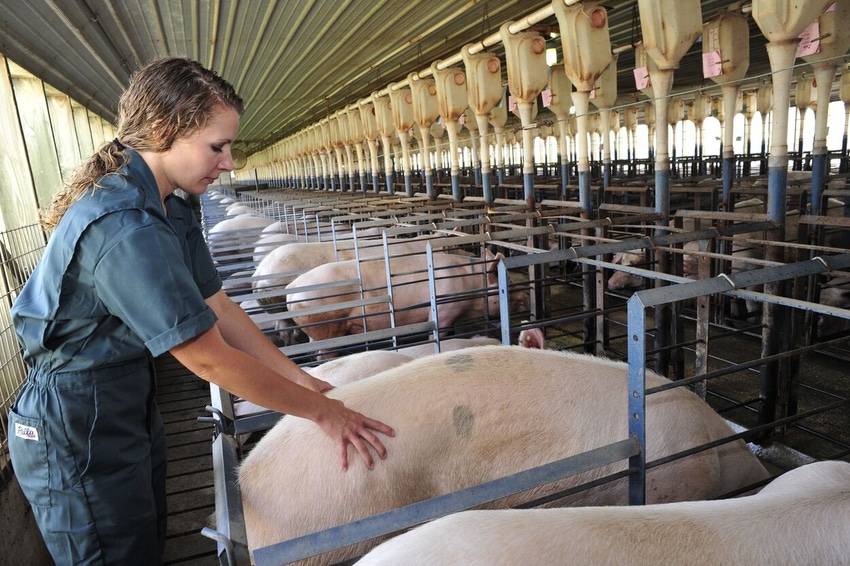
I have been looking at farm records and doing analysis for several years, and I continue to see a lot of variation in performance of first-parity gilts (P1) among farms in several areas. Some of this is due to genetics, facility design, location, gilts development acclimatization, people managing farms and many other things. This article is going to look at farrowing rate as it relates to gilts (P1 females).
With several different sow record keeping systems in the swine industry, it is sometimes hard to compare farms' data and terminologies. The data for this article has been standardized for the 281 farms with a mated female inventory of 568,352 mated females, with pigs weaned/mated female/year at 20-plus pigs for the last 12 quarters. Farms included are from the United States and Canada and range in size of farms from 247 to 8,073 mated females and pigs weaned/mated female/year starting at 20.83, with the top farm at 34.76 pigs. Remember that when gilts are bred in most record systems, they are recorded as a P0, and the day they farrow, they become a P1 so that is why we use P1 farrowing rate for females with their first litter.
The following five charts are set up with the 281 individual farms on the X-axis sorted by farrowing rate for P1 (gilts) starting with lowest below 70% and going to 90+%. The left Y-axis shows farrowing rate % (green line) and on the right Y-axis several pigs weaned/mated female/year, mated female inventory, total born/female farrowed P1, Parity 0 percent repeats, and Parity 0 multiple matings % (orange line). There is also a linear line (black line) showing trends.
Chart 1: Parity 1 Farrowing Rate verses Pigs Weaned/Mated Female/Year shows a trend as farrowing rate of P1 (gilts) goes up, pigs weaned/mated female/year goes up. The distribution goes from 20.83 to 34.76 pigs weaned/mated female/year with a farrowing rate range of 64.4- 96.3% for P1 females.
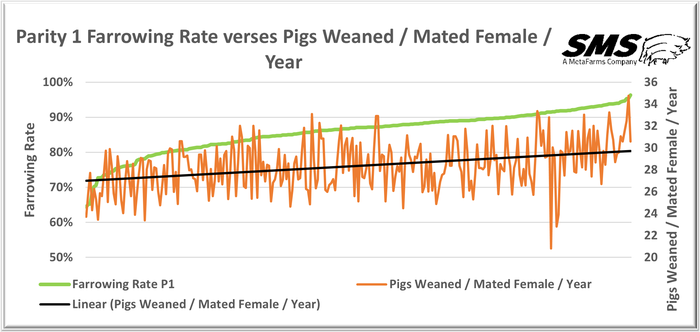
Does the size of farm have any influence on farrowing rate of P1 (gilts)? Chart 2: Parity 1 Farrowing Rate verses Average Mated Female Inventory shows the 281 farms ranged in size from 247- 8,073 mated females. You can see in chart 2, the farrowing rate goes from 96.0% for the last 52 weeks. The trend line (black line) shows a slight trend to larger farms with higher farrowing rates however, the chart does show a lot of variation in farrowing rate by size of farms.
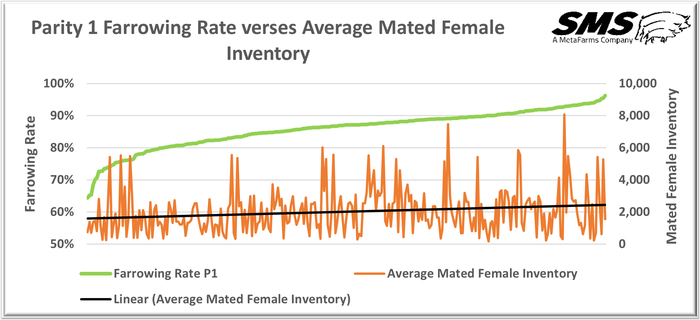
Does farrowing rate of P1 (gilts) influence total born? To look at total born for P1's, you need to review Chart 3: Parity 1 Farrowing Rate verses Total Born/Female Farrowed P1. The chart is set up with the 281 farms ranked by farrowing rate showing a large variation in total born going from 12.70 to 16.75 pigs with three farms below 13.0 pigs and three farms at 16.0+ pigs. There is a slight trend line (black line) for higher farrowing rate improving total born. As we know, total born set the future for each female, with higher total born for P1 producing more pigs in a lifetime. Total born for that first litter is influenced by how many heat cycles a gilt has had before breeding and can also be influenced by placing gilts into a gestation crate for 10+ days before breeding. Goal is to breed gilts on second or third recorded heat cycling weighting at least 300 lb. (135 kg).
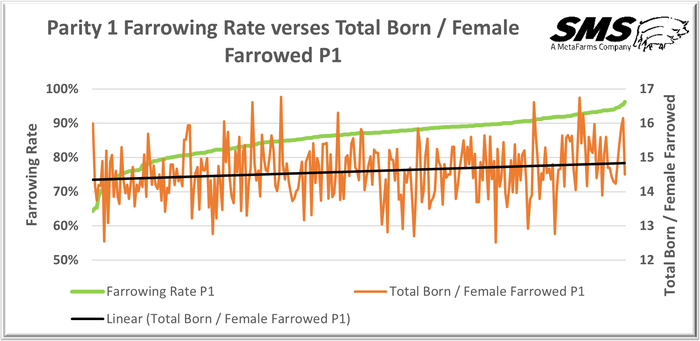
What influences farrowing rate of P1 (gilts)? Chart 4: Parity 1 Farrowing Rate verses Parity 0 Percent Repeats you will see is set up showing percent repeats on the right Y-axis starting at 0 to 30% repeats. The trend line (black line) shows a very high trend line as percent repeats goes up, farrowing rate goes down. You can see in the chart 4, there were four farms with farrowing rate below 70% over the last 52 weeks with percent repeats in a range of 20- 28.7% repeats and 64 farms with farrowing rate at 90- 96.3% showing percent repeats 0.0- 5.0%. It is known that farms have spent a lot of money developing gilts and have a problem culling them if they repeat however, looking at the data, rebreeding repeats does lower farrowing rate which then increases non-productive days.
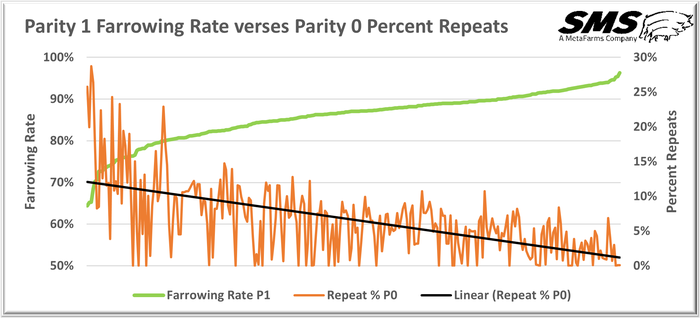
What affect does one mating have on farrowing rate of P1 (gilts)? Looking at Chart 5: Parity 1 Farrowing Rate verses Parity 0 Multiple Matings % you see a very messy table. It was decided to put it in so we can talk about the number of matings. In this table, the right Y-axis shows Percent Multiple Matings with a range going from 0- 100% with most of the farms showing 80- 100% multiple matings. Some lower percent multiple matings is due to how farms are recording matings with some only recording one.
In review of breeding data from farms over many years, I have seen most of the single matings being gilts (P1) and late cycling weaned sows. This has probably had an influence on the number of repeats P0 being rebreed with breeders deciding to give her another chance to conceive instead of being culled.
The top farms with high farrowing rates for gilts (P1) do heat checking and breeding of gilts twice per day in the a.m. and p.m. Since gilts have short heat cycles (around 24 hours), heat checking only once per day has farms missing a lot of gilts that would show estrus in the p.m. if heat checked. There are a lot of gilts bred in the a.m. and the next day in the a.m. not showing signs of heat, so they got only mated one time which usually lowers farrowing rate and if bred the quality of the matings is questionable.
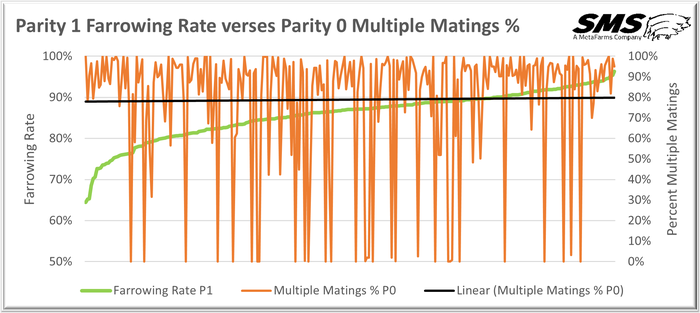
In summary, there is a lot of variation in farrowing rate amongst the farms for P1 females. We know that improving farrowing rate by 3% improved pigs weaned/mated female/year by 1.02 pigs. In previous articles, it was shown there is a direct correlation between farrowing rate of gilts and overall farrowing rate of the farm. With 30+% of all females served at the farm being gilts, they are a big influence on overall farrowing rate.
If your farm is dealing with low farrowing rate of gilts (P1) females, which is less than 90+%, a review of the farm’s breeding program is needed. Remember that farrowing rate is a three-part variable made up of the sow, semen and breeder. Two areas that need to be looked at are number of multiple matings and percent repeats P0's rebred. As mentioned in this article, the farms with a higher farrowing rate for P1’s usually see repeats rebred
To lower the number of single matings, the farm should try heat checking gilts (P0) twice per day, early in the a.m. and at least once later in the p.m. This allows gilts two times per day to be found in heat and gilts breed in the a.m. to get a second mating in the p.m. Then gilts found in heat in the p.m. can get a second mating in the p.m. and again the next morning. There will also be some of these gilts that will be in heat the next day in the a.m. or p.m. that should get a third mating.
What is the farrowing rate of gilts (P1) females at your farm? If not at 90+%, you should review your procedures for breeding gilts and see if single matings and rebreed repeats are pulling down your percent. Remember, farrowing rate of gilts is a big influence on overall farrowing rate of the farm.
Thank you for reading this article. If you have other topics you would like reviewed, please let SMS know.
Sources: Ron Ketchem, 30 & Up Consulting LLC, and Mark Rix, Swine Management Services LLC, who are solely responsible for the information provided, and wholly own the information. Informa Business Media and all its subsidiaries are not responsible for any of the content contained in this information asset.
About the Author(s)
You May Also Like



